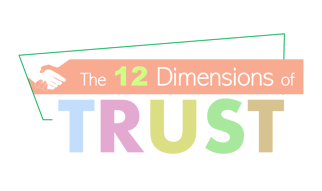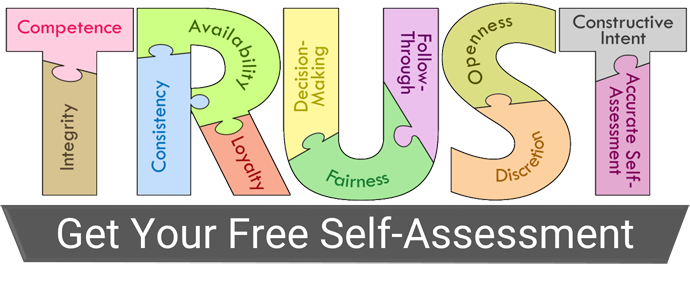More than Honesty & Integrity! Know the 12 Dimensions of Trust
 Trust. It’s a loaded word, a misunderstood construct, and a necessity in the workplace. Without recognizing all 12 dimensions of trust, we all run the risk of inadvertently breaching others’ trust. Similarly, we operate on vague feelings of mistrust that are often unfounded. For something as fragile as trust, these complications only make it harder to form strong bonds and collaborate effectively.
Trust. It’s a loaded word, a misunderstood construct, and a necessity in the workplace. Without recognizing all 12 dimensions of trust, we all run the risk of inadvertently breaching others’ trust. Similarly, we operate on vague feelings of mistrust that are often unfounded. For something as fragile as trust, these complications only make it harder to form strong bonds and collaborate effectively.
When you think of trust, you probably associate it with honesty and integrity. Don’t stop there! With 11 additional dimensions, trust involves so much more. Over the next 12 weeks in this series, we’ll break it down so you can solidly build 2-way trust with your colleagues.
Let’s start with the dictionary definition of trust.
- Reliance on the integrity, strength, ability, surety, etc. of a person or thing; confidence
- Confident expectation of something
- To rely upon or place confidence in someone or something
- Assurance or confidence that invokes a feeling of security
- Unquestioning belief in and reliance upon someone or something
What causes us to have confidence in someone or something? That’s what the 12 Dimensions of Trust will address.
The word “trust” was originally derived from a German cognate “trost” which meant “comfort.” When trust is strong, we are more comfortable with others. We can take comfort in the words and actions of those we trust. Without trust, relationships and outcomes are compromised and leave us feeling less secure and less confident.
Unfortunately, there are times when we don’t know why we are unable to trust others or why they don’t entirely trust us. Knowing about all 12 Dimensions of Trust will help you work through those uncertainties, establish stronger bonds of trust, restore any relationships harmed by inadvertent breaches of trust, and maintain higher levels of trust with others.
What Are the 12 Dimensions of Trust?
Week-by-week, we’ll break these down in this blog series so you can get a more complete picture of what each one entails. We’ll examine ways that people inadvertently breach trust in each dimension and at the behaviors that will help you shore up your trustworthiness in each dimension, too.
The 12 Dimensions of Trust that enable us to have confidence in someone are:
- Integrity (including honesty)
- Competence
- Consistency
- Loyalty
- Availability
- Fairness
- Decision Making
- Follow Through
- Openness
- Discreteness
- Constructive Intent
- Accurate Self-Assessment
To assess yourself on the 12 Dimensions of Trust, download this free tool from People First Productivity Solutions.
How Knowing the 12 Dimensions of Trust Will Make You More Trustworthy
You may consider yourself to be trustworthy because you operate with integrity and are an honest person. You don’t lie, cheat, steal, or make self-serving decisions. You may believe that you are above reproach or blameless in relationships where trust has been broken.
Feeling that way is often the result of thinking too narrowly about what it takes for others to fully trust you. Many people who display honesty and integrity fail to realize that they’re doing other things that make them less trustworthy.
Take, for example, a colleague who is reserved and a bit guarded. She’s honest and has good integrity. But she’s closed off, seldom engages, and doesn’t readily share information about herself or her views. As a result, others aren’t able to fully trust her. She’s inadvertently breaching trust because she’s not displaying the dimensions of availability and openness.
Here’s another example. A manager who is honest and open and full of integrity seems to attack others with candid feedback and harsh criticism. The manager is well-intended, but others don’t understand that the criticism is meant to be helpful. To them, it just feels like bullying. They don’t trust the manager because the dimension of constructive intent is not apparent.
Style dimensions like these require self-awareness, emotional intelligence, and an understanding of how they affect others’ abilities to trust you.
Knowing all 12 Dimensions of Trust, honestly assessing yourself in them, and deliberately working to be solid in all 12 will make it easier for others to trust you.
How Knowing the 12 Dimensions of Trust Will Make It Easier to Trust Others
Ever have a vague feeling that you can’t trust a certain person? We think of it as “gut instinct” instead of pinpointing what’s keeping us from more fully trusting them. Because we don’t trust them, we inhibit the growth of that relationship and interact with them cautiously. Soon, they are not able to trust us either because we’re not displaying availability, fairness, or openness with them.
It’s not fair to them (or to us) to let that non-specific feeling linger and impair our ability to collaborate and count on each other. Using the 12 Dimensions of Trust as a diagnostic tool can help you identify what’s keeping you from trusting the other person. Once you know, you can have a frank discussion and re-establish trust.
As you work with this tool, you’ll soon discover that certain dimensions of trust are more important to you than others are. You’ll notice that what’s a big deal to you is less important to some others.
A classic case of having different trust priorities relates to the dimension of follow through. For some, this is a BIG deal. When others don’t follow through on promises and commitments, there’s a lingering doubt or suspicion that colors the relationship. For others, that lack of follow through is tolerable and easily overlooked. The second type might consider the first to be uptight and rigid… Nonetheless, the first type won’t trust the folks who fail to follow through.
In the workplace, teams who work through the 12 Dimensions learn to identify their trust triggers and to respect others. Most teams can immediately begin the work of rebuilding trust once team members understand that others didn’t mean to violate their trust, that different trust priorities lead to different actions, and that open dialogue about the 12 Dimensions offers an easy reset.
To learn more about the 12 Dimensions of Trust, read the full series here in the CONNECT2Lead Blog. You can also enroll in this free workshop or work with People First Productivity Solutions to bring a customized workshop to your team.
